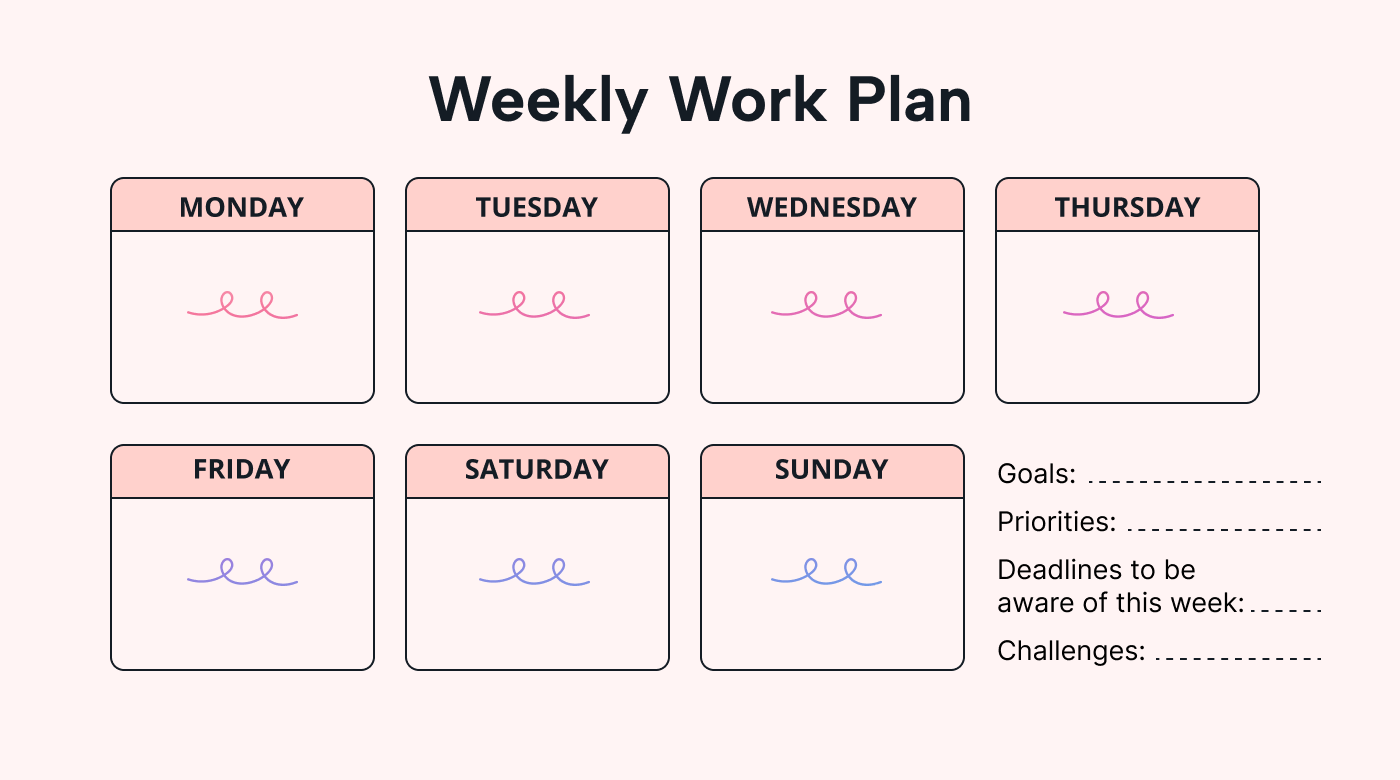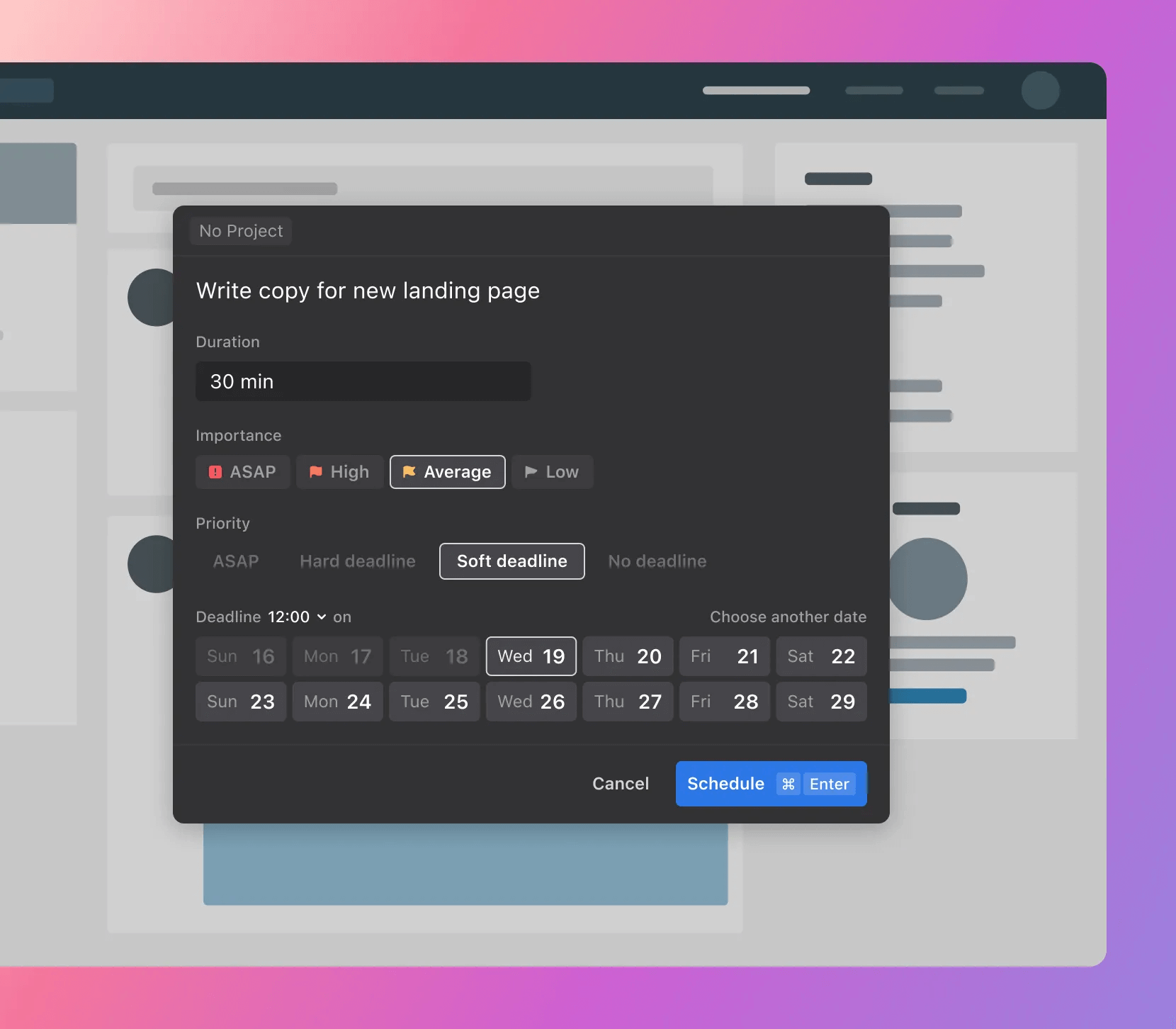You know what they say: if you fail to plan, you are planning to fail.
In the dynamic world of work, planning isn’t just proverbial wisdom — it’s a necessity.
A weekly work plan can serve as the compass that navigates you through the complexities of tasks, meetings, and deadlines. It isn’t just about listing tasks but building a week that is both productive and balanced.
This guide will offer insights into crafting a robust weekly work plan to help you make your weeks more strategic, focused, and rewarding.
What is a weekly work plan?
A weekly work plan is a structured document that outlines the tasks, project goals, and activities planned for a specific week. It’s typically broken down into days, as this makes it easier to visualize and track progress throughout the week.
A weekly work plan should include the following:
Objectives
These are the main goals or outcomes that need to be achieved by the end of the week. They provide a clear direction and purpose for the week’s activities, ensuring that all tasks align with the broader strategic aims.
Tasks and activities
These are the specific actions required to accomplish the objectives, often including both high-priority tasks and smaller supporting activities. This breakdown helps distribute efforts across the week, ensuring a balanced workload and minimizing the risk of burnout.
Resources
Identifying the resources needed for the week’s tasks, including the required materials, tools, information, and personnel, helps ensure efficient planning and avoid potential delays caused by resource shortages.
Deadlines
Each task or activity in the plan should have a specific deadline. These deadlines help in maintaining a schedule, promoting accountability, and ensuring timely progress toward the objectives.
Deadlines also assist in prioritizing tasks, especially when managing multiple projects or when unexpected challenges arise.
Benefits of a weekly work plan
Weekly planning can enhance both your personal and professional life. Here’s a closer look at why a work plan is beneficial:
Improves focus
Imagine starting your week with a clear, carefully plotted roadmap. This is what a weekly work plan offers. It acts as a guiding light, keeping you focused on your ultimate goal for the week.
 |
With a clearly defined set of objectives for the week, it becomes easier to sidestep the distractions that often derail us.
Allows for better time management
A weekly work plan helps to ensure that each hour of your workday is assigned a meaningful task. It lets you distribute your workload evenly over the week, preventing the all-too-common pitfall of overcommitting on one day and underperforming on another.
By allocating time to specific tasks, you become the master of your daily schedule — able to balance your professional responsibilities with your personal time and, ultimately, have a more harmonious life.
Increases productivity
Not having a clear plan for the day can mean spending precious minutes every morning deciding what to tackle first.
A weekly work plan removes this indecision, effectively reducing the time you need to spend planning out each day.
With a predefined agenda, you can hit the ground running every morning when you wake up.
Reduces stress
A well-organized week is a less stressful one. The anxiety that comes from looming deadlines or worrying about forgetting pressing tasks is significantly alleviated when you have a structured plan.
Having a weekly work plan gives you control over your tasks and responsibilities, which helps reduce your fear of getting lost or off-track.
Enhances accountability
A written work plan is a documented commitment to yourself and your responsibilities. It acts as a personal contract, holding you accountable for the tasks at hand. And this accountability is a powerful motivator — you’re more likely to follow through with your commitment because someone (in this case, your plan) is keeping track.
How to write a weekly work plan
Writing a weekly work plan is a straightforward, effective process that helps you achieve your goals with organization and focus. Here are the steps to creating one:
 |
1. Define your goals
Begin by setting clear, achievable goals for the week and writing them down. These goals should align with your broader objectives, whether they’re project milestones, personal growth targets, or business outcomes.
2. Break down tasks
Break your goals down into smaller, manageable tasks that can be tackled daily.
For instance, if your goal is to complete a project, your tasks might include researching, drafting, reviewing, and finalizing.
3. Allocate resources
Determine the resources you’ll need to accomplish each task. This could include materials, information, software, or even assistance from colleagues or team members.
Make sure these resources are available and accessible throughout the week.
4. Set deadlines
Assign realistic deadlines for each task. Consider your other commitments and potential interruptions when doing this.
Deadlines help you maintain a steady pace and prevent tasks from dragging on indefinitely.
5. Review and adjust
At the end of the week, take time to review what you’ve accomplished. Celebrate your achievements, no matter how small, and reflect on what could have gone better. Use these insights to adjust the following week’s plan, accommodating any pending tasks.
Weekly work plan template
Below is a convenient weekly planner template for you to use. Feel free to edit it based on your work week and requirements.
Week of: [Enter Date Range]
Name/Team: [Enter Name or Team]
Weekly Objectives:
Objective 1
Objective 2
Objective 3
Priorities for the Week:
Priority Task 1
Priority Task 2
Priority Task 3
Key Deadlines:
Deadline 1: [Task - Date/Time]
Deadline 2: [Task - Date/Time]
Deadline 3: [Task - Date/Time]
Challenges/Anticipated Roadblocks:
Challenge 1
Challenge 2
Challenge 3
Now that you’ve listed the elements to consider for the entire week, break down your day into sections and decide what tasks to do when.
Daily Breakdown:
Monday–Friday
Morning Tasks (8 AM–12 PM):
Task Block 1 (1–2 hours)
Task Block 2 (1–2 hours)
Afternoon Tasks (1 PM–5 PM):
Task Block 3 (1–2 hours)
Task Block 4 (1–2 hours)
End of Day (5 PM–6 PM):
Here, include tasks to do if everything else is completed (long-term projects, preparations for the next day, etc.).
Notes/Comments:
Add anything notable about your day.
 |
Using this weekly schedule template, here’s an example of a project manager’s work plan for a Monday:
Monday work plan
Date: November 13
Name/Team: John Doe/Project Management Team
Monday’s Focus: Setting the stage for the week’s deliverables and addressing immediate tasks
Morning Tasks:
8 AM–9 AM: Review and respond to critical emails from stakeholders
9 AM–11 AM: Update Project X’s progress in the project management software
11 AM–12 PM: Finalize the weekly status report for the Monday team briefing
Afternoon Tasks:
1 PM–2 PM: Conduct the weekly project team meeting
2 PM–4 PM: One-on-one with the design team lead to discuss Project Y’s milestones
4 PM–5 PM: Outline the risk assessment strategy for Project Z
End of Day:
5 PM–6 PM: Review today’s progress and plan for Tuesday’s tasks
Notes/Comments:
The team meeting may be extended; buffer time has been allocated tomorrow for overflow tasks.
Prepare contingency plans in case of stakeholder feedback delays.
The project manager would continue to do the same for the rest of the week. They’d ensure that any feedback from Monday’s meetings is integrated into the project timeline.
5 tips for creating an effective weekly work plan template
Keep the following best practices in mind when creating your weekly work plan:
1. Use tools to your advantage
Leverage technology to streamline your planning process.
Motion not only allows you to schedule tasks but also predicts the time needed for each task based on your past performance. It can automatically reschedule your tasks if you fall behind and even block out time for deep work, ensuring that periods of concentration remain uninterrupted.
 |
2. Batch similar tasks
Group similar tasks together to increase efficiency. This technique, known as task batching, minimizes the time lost switching between different types of daily tasks.
For example, allocate dedicated time blocks for all your email-related work, another for meetings, and a different one for creative tasks. This approach can significantly improve your focus and productivity, as it allows your brain to stay in the same “mode” for longer periods.
3. Include some buffer time
Unexpected issues are part of any workday. When planning your week, include some buffer time to accommodate these unforeseen events or tasks that may take longer than anticipated. This flexibility can reduce stress and prevent your entire plan from being derailed by a single delay.
4. Set clear boundaries
Define clear start and end times for your workday. This helps you maintain a healthy work-life balance and prevents burnout. Knowing you have a designated time to switch off can also increase your focus and efficiency during work hours.
5. Be realistic
It’s important to set achievable weekly goals and avoid overburdening yourself with an unrealistic number of tasks. Understand your limits, and plan your week accordingly.
Being realistic with your time and abilities will lead to more consistent and sustainable productivity, and you’ll be less likely to feel overwhelmed as a result.
Create your weekly work plan template in Motion
A weekly work plan is more than just a list — it’s a strategy for success. By taking the time to plan your week, you set yourself up for heightened productivity, better time management, and a clearer mindset.
Tools like Motion further streamline your planning process and ensure you make the most of every week. Motion consolidates your meetings, tasks, to-do lists, and other activities to create an optimal, personalized schedule.
Ready to take control of your week? Try out Motion with a 7-day free trial and discover how organized planning can revolutionize your workflow.





